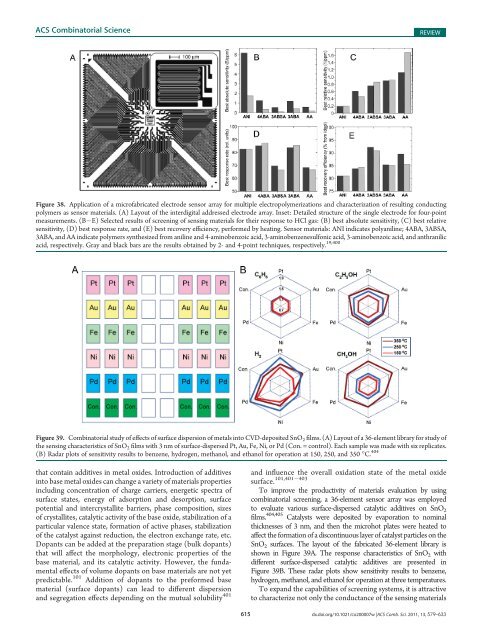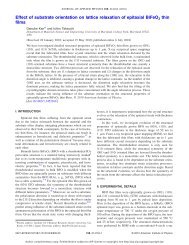Combinatorial and High-Throughput Screening of Materials ...
Combinatorial and High-Throughput Screening of Materials ...
Combinatorial and High-Throughput Screening of Materials ...
Create successful ePaper yourself
Turn your PDF publications into a flip-book with our unique Google optimized e-Paper software.
ACS <strong>Combinatorial</strong> Science<br />
REVIEW<br />
Figure 38. Application <strong>of</strong> a micr<strong>of</strong>abricated electrode sensor array for multiple electropolymerizations <strong>and</strong> characterization <strong>of</strong> resulting conducting<br />
polymers as sensor materials. (A) Layout <strong>of</strong> the interdigital addressed electrode array. Inset: Detailed structure <strong>of</strong> the single electrode for four-point<br />
measurements. (B E) Selected results <strong>of</strong> screening <strong>of</strong> sensing materials for their response to HCl gas: (B) best absolute sensitivity, (C) best relative<br />
sensitivity, (D) best response rate, <strong>and</strong> (E) best recovery efficiency, performed by heating. Sensor materials: ANI indicates polyaniline; 4ABA, 3ABSA,<br />
3ABA, <strong>and</strong> AA indicate polymers synthesized from aniline <strong>and</strong> 4-aminobenzoic acid, 3-aminobenzenesulfonic acid, 3-aminobenzoic acid, <strong>and</strong> anthranilic<br />
acid, respectively. Gray <strong>and</strong> black bars are the results obtained by 2- <strong>and</strong> 4-point techniques, respectively. 19,400<br />
Figure 39. <strong>Combinatorial</strong> study <strong>of</strong> effects <strong>of</strong> surface dispersion <strong>of</strong> metals into CVD-deposited SnO 2 films. (A) Layout <strong>of</strong> a 36-element library for study <strong>of</strong><br />
the sensing characteristics <strong>of</strong> SnO 2 films with 3 nm <strong>of</strong> surface-dispersed Pt, Au, Fe, Ni, or Pd (Con. = control). Each sample was made with six replicates.<br />
(B) Radar plots <strong>of</strong> sensitivity results to benzene, hydrogen, methanol, <strong>and</strong> ethanol for operation at 150, 250, <strong>and</strong> 350 °C. 404<br />
that contain additives in metal oxides. Introduction <strong>of</strong> additives<br />
into base metal oxides can change a variety <strong>of</strong> materials properties<br />
including concentration <strong>of</strong> charge carriers, energetic spectra <strong>of</strong><br />
surface states, energy <strong>of</strong> adsorption <strong>and</strong> desorption, surface<br />
potential <strong>and</strong> intercrystallite barriers, phase composition, sizes<br />
<strong>of</strong> crystallites, catalytic activity <strong>of</strong> the base oxide, stabilization <strong>of</strong> a<br />
particular valence state, formation <strong>of</strong> active phases, stabilization<br />
<strong>of</strong> the catalyst against reduction, the electron exchange rate, etc.<br />
Dopants can be added at the preparation stage (bulk dopants)<br />
that will affect the morphology, electronic properties <strong>of</strong> the<br />
base material, <strong>and</strong> its catalytic activity. However, the fundamental<br />
effects <strong>of</strong> volume dopants on base materials are not yet<br />
predictable. 101 Addition <strong>of</strong> dopants to the preformed base<br />
material (surface dopants) can lead to different dispersion<br />
<strong>and</strong> segregation effects depending on the mutual solubility 401<br />
<strong>and</strong> influence the overall oxidation state <strong>of</strong> the metal oxide<br />
101,401 403<br />
surface.<br />
To improve the productivity <strong>of</strong> materials evaluation by using<br />
combinatorial screening, a 36-element sensor array was employed<br />
to evaluate various surface-dispersed catalytic additives on SnO 2<br />
films. 404,405 Catalysts were deposited by evaporation to nominal<br />
thicknesses <strong>of</strong> 3 nm, <strong>and</strong> then the microhot plates were heated to<br />
affect the formation <strong>of</strong> a discontinuous layer <strong>of</strong> catalyst particles on the<br />
SnO 2 surfaces. The layout <strong>of</strong> the fabricated 36-element library is<br />
shown in Figure 39A. The response characteristics <strong>of</strong> SnO 2 with<br />
different surface-dispersed catalytic additives are presented in<br />
Figure 39B. These radar plots show sensitivity results to benzene,<br />
hydrogen, methanol, <strong>and</strong> ethanol for operation at three temperatures.<br />
To exp<strong>and</strong> the capabilities <strong>of</strong> screening systems, it is attractive<br />
to characterize not only the conductance <strong>of</strong> the sensing materials<br />
615 dx.doi.org/10.1021/co200007w |ACS Comb. Sci. 2011, 13, 579–633












